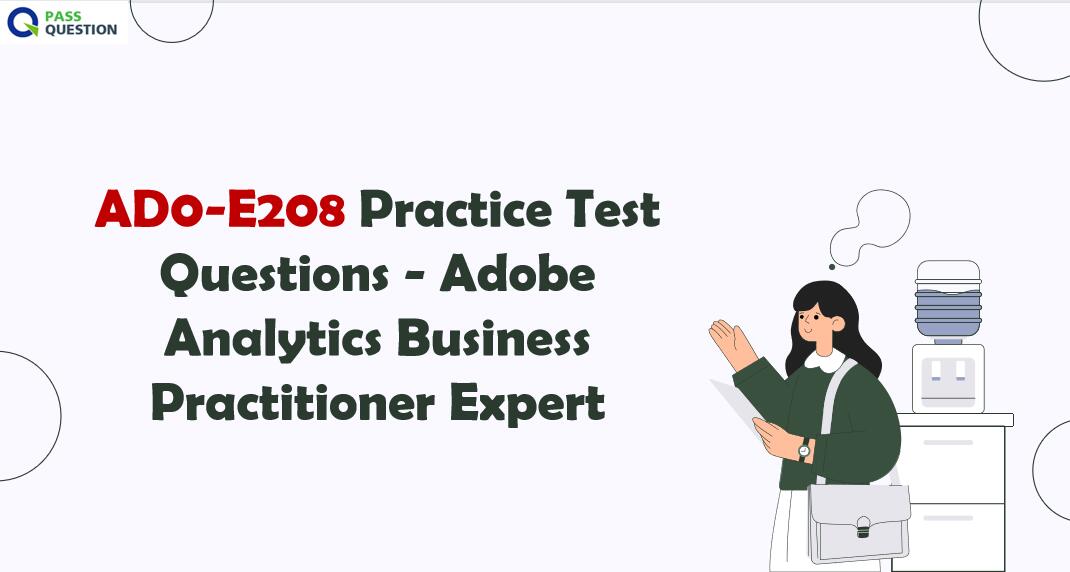AD0-E208 Practice Test Questions - Adobe Analytics Business Practitioner Expert
If you want to pass the AD0-E208 Adobe Analytics Business Practitioner Expert exam with confidence and advance your career in analytics. PassQuestion AD0-E208 Practice Test Questions is an exceptional preparation tool that provides candidates with everything they need to excel in the exam. The AD0-E208 Practice Test Questions are expertly designed to help candidates gain a deep understanding of the exam objectives and scope, practice with real exam questions, and evaluate their readiness for the exam. By using PassQuestion AD0-E208 Practice Test Questions, candidates can gain the confidence they need to ace the exam and achieve their career goals.

Exam Details:
Level: Expert (1-3 years' experience)
Passing Score: 31/50
Time: 120 mins
Delivery: Online proctored (requires camera access) or >test center proctored
Available languages: English
Cost: $225 (global) / $150 (India)
Exam ID: AD0-E208
Exam Objectives and scope
Section 1: Understanding Analytics in the Adobe Experience Cloud Ecosystem (10%)
- Demonstrate knowledge on utilizing the Adobe Experience Cloud ID
- Demonstrate understanding of Adobe Launch
- Demonstrate understanding of common integrations across the Adobe Experience Cloud Ecosystem
Section 2: Reporting and dashboarding for projects (30%)
- Consider the advantages of using a reporting tool based on a given scenario
- Compare fallout and flow visualization and appropriate variable types for reporting
- Apply the process to schedule Projects and Data Warehouse
- Apply the process to share Projects and Reporting and Analytics dashboards for different users and/or groups
- Apply the process to set Alerts
- Apply the process to lookup the dimensions/components
- Apply the process to create a visualization
- Given a scenario, determine the appropriate item to use
- Apply the process to create, configure, and use mobile scorecards
Section 3: Segmentation and calculated metrics (22%)
- Determine how to develop and configure segments
- Apply the process to share segments with others in the organization
- Compare segments
- Apply segments to Projects and Components
- Apply the process to generate calculated and/or segmented metrics
Section 4: General tool knowledge and troubleshooting (12%)
- Analyze reports and identify data quality issues
- Define different types of dimensions and parameters existing in Adobe Analytics (eVars, props and events)
- Determine how to bring data in and out of Adobe Analytics
- Identify information from marketing URLs
Section 5: Administration (10%)
- Apply the process to configure the Marketing Channel reports with Marketing Channel processing rules
- Apply the process to configure Classification Importer and Rule Builder
- Apply the process to configure a virtual report suite based upon an existing segment
- Use the Data Feed Manager Admin UI
- Understanding of data governance
View Online Adobe Analytics Business Practitioner Expert AD0-E208 Free Questions
1. A bank client wants to understand usage of their mobile website by geographical region.
The analytics team is tasked with creating segments to provide this data.
Why would the analytics team decide to use segment stacking in the Segment Builder?
A. It breaks a consolidated segment down into multiple granular segments.
B. It provides the ability to consolidate more granular segments into one combined segment.
C. It bypasses the limit on the number of segments per report.
Answer: B
2. An analyst wants to use all of the following variables to configure a single fallout report:
• Landing page prop
• Marketing channel eVar
• Product view event
• Purchase event
• Product category eVar
Which tool should the analyst use?
A. Segment builder
B. Workspace
C. Reports and analysis
Answer: B
3. In Analysis Workspace a Flow Visualization can be created.
What is the benefit of using the correct configuration of Flow Visualization?
A. It enables the expansion of a column to show all nodes. By default, only the top five nodes are displayed.
B. It is based on instances of a dimension. However, this configuration does not offer the option to exclude repeated instances, for example, Page reloaded.
C. It allows analyzation of the visitor's path for the same visit only
Answer: A
4. When changing the Fallout visualization from Eventual Path to Next Hit, the analyst notices that the data reports zero Visitors across the report.
Why would this occur?
A. Across all visitors, the fallout depicted never was completed as a next step conversion.
B. Across all visitors, the fallout depicted never was completed as an eventual path conversion.
C. There was no direct path from the second and third fallout touchpoints.
Answer: A
5. In Analysis Workspace, which two types of components can be used in order to filter the scope of the report to a specific section of the website? (Choose two.)
A. Dimensions
B. Segments
C. Time
D. Standard Metrics
Answer: B,C
6. In Analysis Workspace, what are two ways a Map Visualization can be built? (Choose two.)
A. Representing geo segmentation data about visitor location on the DMA or Zip Code level
B. Using IP address or Latitude/Longitude
C. Building a Map Visualization using one metric (including calculated metrics)
D. Building a Map Visualization using two or more metrics (including calculated metrics)
Answer: A,C
- TOP 50 Exam Questions
-
Exam
All copyrights reserved 2025 PassQuestion NETWORK CO.,LIMITED. All Rights Reserved.

